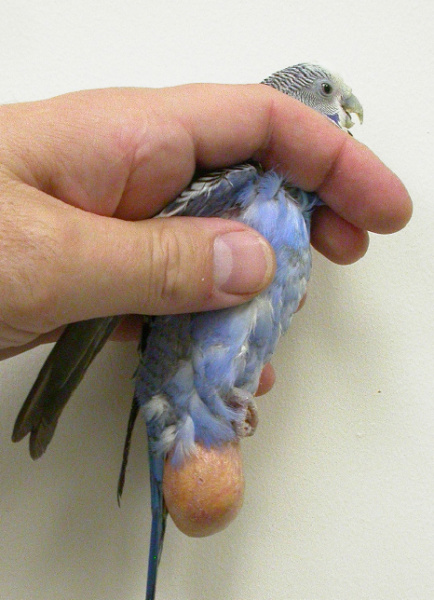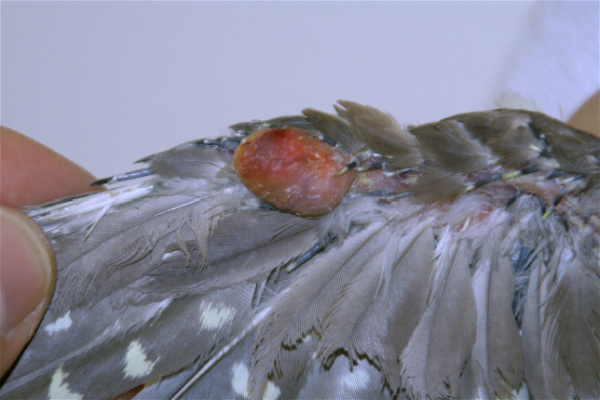Xanthomas in Birds
Tumors: Xanthomas in Birds
The Following Article and Photos are By Gregory Rich, DVM; Rick Axelson, DVM
Xanthomas are discrete masses or diffuse, thickened areas of skin that are a yellowish-orange color with a dimpled surface. They are accumulations of fat and cholesterol that are primarily seen in cockatiels and parakeets (budgies), especially in females.

"Genetic predispositions, high fat or high cholesterol diets ,and trauma may be contributory to their formation."
The wing tips, breast region, and the area of the bird's ventral abdomen (between the legs and around the vent) are the most common sites of xanthomas. They are often locally invasive and destructive. This infiltrative tissue is weak or friable and can be easily damaged or ulcerated, especially as it proliferates and gets bigger. Birds will sometimes cause self-trauma by picking at them. The specific cause of xanthomas is currently unknown. Genetic predispositions, high fat or high cholesterol diets, and trauma are thought be contributory to their formation.
Are there any treatments for xanthomas?
It has been reported that some individual birds will respond to nutritional therapy. Often these birds are on high fat, all seed diets. Weaning slowly onto a balanced diet (pellets and vegetables, with limited fruit as treats), plus supplementation with vitamin A or vitamin A precursors, may be successful. If the xanthoma continues to enlarge, or becomes ulcerated, bleeding, infected, or painful, surgical removal is required. If the mass is left untreated, it may become large enough to impair the bird's movements. In addition, the bird becomes susceptible to sudden bleeding episodes and may bleed to death.
"The more complete the excision, the less likely the tumor will recur."
The goal of surgery is to completely remove the xanthoma and any surrounding fatty, necrotic, or ulcerated skin. The more complete the excision (removal with a sharp instrument), the less likely the tumor will recur. Sometimes the tissue spreads so far into the surrounding skin that surgical excision may be incomplete; in these cases, the mass will be debulked as much as possible. In some cases, the xanthoma is so large that to remove it all would not leave enough healthy skin to close the surgical wound. Suturing incompletely removed xanthomatous tissue is complicated by the fact that the tissue is weak and may not hold the sutures well. Often times, the only way to remove a xanthoma from the wing tip is by surgical amputation. Large xanthomas on the abdomen are extremely difficult to remove surgically, as there is usually not enough healthy skin to close the surgical site, so early intervention and a health exam is critical.
Consult a veterinarian familiar with birds for further guidance.

Xanthoma: The OTHER Fatty Skin Mass
By Patty J. Ewing, DVM, MS, DACVP (Anatomic and Clinical Pathology)
When fatty tumors are mentioned, lipoma is typically what comes to mind. However, there is another, less common fatty tumor-like mass known as xanthoma that should be considered, especially when evaluating birds with one or more skin masses. In this brief article, xanthomas in birds, cats and dogs will be reviewed with a special focus on the use of cytology and histopathology to diagnose this unique entity
Xanthomas (also known as xanthomatosis or xanthogranuloma) appear as discrete yellow nodules, plaques or thickenings in the skin (Figure 1) that can increase in size over time and be locally invasive. The non-neoplastic masses are composed of cholesterol, cholesterol esters and other lipids that induce a granulomatous inflammatory reaction at one of more sites. Xanthomas have been reported in psittacine and gallinaceous birds with single case reports in a goose, American kestrel, and a great white pelican. They are relatively common skin masses in cockatiels and female budgerigars. In addition to birds, xanthomas have been described in humans, cats, dogs, horses, amphibians and reptiles. The most common cutaneous sites observed in birds are wings, dorsal cervical region, sternum, back, ventral abdomen and uropygial area. Although they are most frequently observed in the skin, they have also been reported in the conjunctiva, internal structures of the eye, oral cavity, internal organs, tendons/periarticular regions, and remote sites such as bone marrow. In cats, they most often occur in periocular and periorbital regions, legs, trunk or footpads, while in dogs, they typically occur on the face, ears, and ventrum.
The cause of xanthoma formation is not definitively known; however, some predisposing factors are shown in Table 1. Solitary cutaneous xanthomas are often idiopathic. When solitary or multiple cutaneous xanthomas (“xanthomatosis”) are identified in animals, evaluation of the diet for high fat content (especially seed-based diets in birds) and determination of serum
cholesterol and triglyceride concentrations are indicated. Cutaneous xanthomas have been reported in cats with primary idiopathic familial hypertriglyceridemia and secondary hyperlipidemia due to diabetes mellitus, glucocorticoid therapy or progesterone therapy. Xanthomas have been experimentally induced in quails and mice deficient in either apolipoprotein E21 or low-density lipoprotein receptors when fed a diet high in cholesterol. In dogs, cutaneous xanthomas have been reported with hyperlipidemia secondary to diabetes mellitus and idiopathic hyperlipidemia.
A definitive diagnosis of xanthoma requires histopathology. The masses appear histologically as sheets of foamy macrophages and fewer multinucleated giant cells (Figure 2) interspersed with cholesterol and lipid deposits. Histologic differential diagnosis includes granulomatous inflammation due to infectious etiologies, especially mycobacteriosis. For this reason, special stains and/or molecular diagnostics to exclude fungal and mycobacterial organisms as a cause of the inflammation are generally recommended. Fine needle aspiration for cytologic evaluation is a useful non-invasive method of obtaining a presumptive diagnosis of xanthoma/xanthomatosis. An example of cytologic features typical of a xanthoma is shown in figure 3. The predominant cell type found in cytologic specimens is finely vacuolated (foamy or lipid-laden) macrophages. Multinucleated giant cells and low numbers of neutrophils, eosinophils, lymphocytes and plasma cells may also
be present. The background often has cholesterol crystals and round, clear areas typical of fat droplets. Cholesterol crystals are non-staining (clear) or pale basophilic staining angular, notched plates which may occur singly or in stacks or clusters.
The treatment of choice for solitary cutaneous or oral xanthomas that are ulcerated, infected or large enough to interfere with function is surgical excision. Incomplete excision can lead to recurrence or poor wound healing. In some cases, the extent of tissue involvement and/or the location of the mass may preclude surgical excision. Cautery to control hemorrhage and use of an Elizabethan collar to prevent self-mutilation in birds may be helpful. Smaller, solitary quiescent xanthomas that are not bothering the bird are frequently not excised and just monitored periodically for increase in size. Prior to surgery and especially when multiple xanthomas are present, evaluation for underling dietary, metabolic, toxic and endocrinologic disorders is warranted. Treatment of predisposing conditions including dietary modification may improve xanthomatosis.
| Table 1. Predisposing Conditions To Consider For Xanthoma Formation |
| Hypercholesteremia/hyperlipidemia caused by: – High-fat diet |
| Prior tissue necrosis at the site |
| Prior hemorrhage due to trauma or feather cyst removal |
| Exposure to toxic fat-soluble substances (example: chlorinated hydrocarbons) |
| Underlying cysts, lipomas or other tumors |

My collared dove ( captive as she has a damaged wing muscle and cannot be released into the wild) has been with me for four years and five months ago developed a lump on her chest. It grew slowly but became the size of a walnut. After about five months it resembled a ball shape and simply fell off leaving a small hole in her chest which was clean and no signs of infection. A vet friend of mine said it was a xanthoma. The dove seems unaffected by the growth and the advice of a different vet several months ago to euthanise her was incorrect.
I have photos if anyone is s interested!
Hi Heidi, i have a budgie now having this issue. It was near her vent and also doesn’t seem to affect her much except that it looks heavy to me and is putting unnecessary weight on her. I had brought her to remove it before but it cannot be removed completely and now the lump has grown larger and making me so worried that I am thinking of taking the route of euthanasia. Please advise me is there any way that I can do or I should just wait it out? Thanks!
I have a female parakeet Amy. Has a growth by her vent which is the size of a small marble.she is 3 years old. Avian vet mentioned it is a hernia. Can do surgery not sure what to do. Any advice. Thanks Alan
I have a macaw and he has a growth the size of a chicken egg . Not sure what to do